Business Decision Making Essay: A&B plc, Suffolk University
VerifiedAdded on 2023/01/07
|8
|1384
|61
Essay
AI Summary
This essay delves into the critical aspects of business decision-making, utilizing a case study of A&B plc, a UK-based restaurant chain. The analysis encompasses the computation of payback periods and the calculation of Net Present Value (NPV) for two projects: a dishwashing project and a software project. The essay evaluates the financial and non-financial factors influencing decision-making, emphasizing their roles in investment appraisal. It highlights the advantages and disadvantages of both the payback period and NPV methods, providing a comprehensive comparison to determine the most viable project for the company. The essay also discusses the importance of considering financial factors such as gross profit and current ratios and non-financial factors like economic conditions to make informed business decisions. The conclusion synthesizes the findings, underscoring the significance of a well-structured decision-making process for achieving business goals.

Business Decision
Making
Making
Paraphrase This Document
Need a fresh take? Get an instant paraphrase of this document with our AI Paraphraser

Table of Contents
INTRODUCTION...........................................................................................................................3
MAIN BODY..................................................................................................................................3
1. Computation of payback period:............................................................................................3
2. Calculation of NPV in project A and B:.................................................................................3
3. Analysis..................................................................................................................................4
CONCLUSION...............................................................................................................................6
REFERENCES................................................................................................................................7
INTRODUCTION...........................................................................................................................3
MAIN BODY..................................................................................................................................3
1. Computation of payback period:............................................................................................3
2. Calculation of NPV in project A and B:.................................................................................3
3. Analysis..................................................................................................................................4
CONCLUSION...............................................................................................................................6
REFERENCES................................................................................................................................7
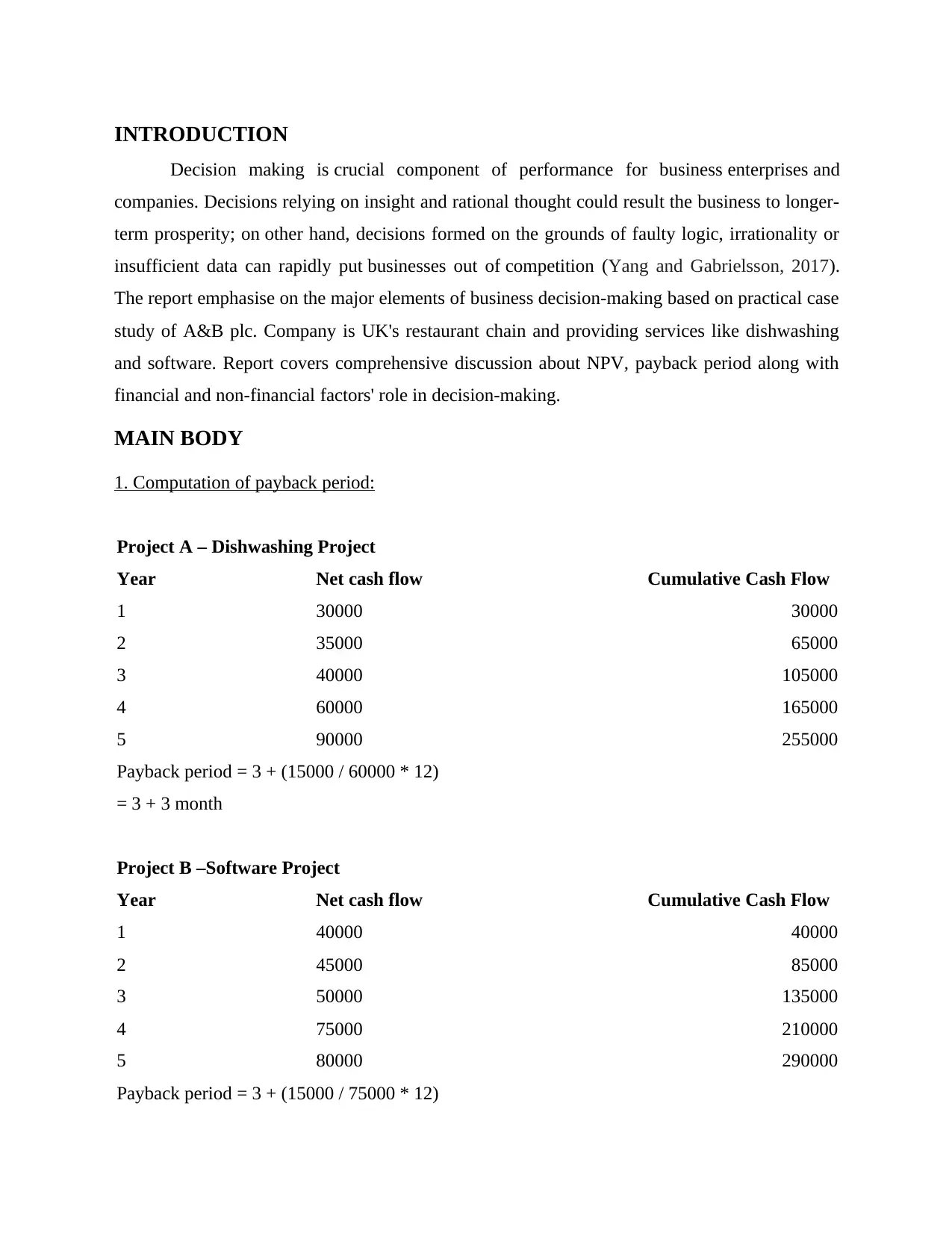
INTRODUCTION
Decision making is crucial component of performance for business enterprises and
companies. Decisions relying on insight and rational thought could result the business to longer-
term prosperity; on other hand, decisions formed on the grounds of faulty logic, irrationality or
insufficient data can rapidly put businesses out of competition (Yang and Gabrielsson, 2017).
The report emphasise on the major elements of business decision-making based on practical case
study of A&B plc. Company is UK's restaurant chain and providing services like dishwashing
and software. Report covers comprehensive discussion about NPV, payback period along with
financial and non-financial factors' role in decision-making.
MAIN BODY
1. Computation of payback period:
Project A – Dishwashing Project
Year Net cash flow Cumulative Cash Flow
1 30000 30000
2 35000 65000
3 40000 105000
4 60000 165000
5 90000 255000
Payback period = 3 + (15000 / 60000 * 12)
= 3 + 3 month
Project B –Software Project
Year Net cash flow Cumulative Cash Flow
1 40000 40000
2 45000 85000
3 50000 135000
4 75000 210000
5 80000 290000
Payback period = 3 + (15000 / 75000 * 12)
Decision making is crucial component of performance for business enterprises and
companies. Decisions relying on insight and rational thought could result the business to longer-
term prosperity; on other hand, decisions formed on the grounds of faulty logic, irrationality or
insufficient data can rapidly put businesses out of competition (Yang and Gabrielsson, 2017).
The report emphasise on the major elements of business decision-making based on practical case
study of A&B plc. Company is UK's restaurant chain and providing services like dishwashing
and software. Report covers comprehensive discussion about NPV, payback period along with
financial and non-financial factors' role in decision-making.
MAIN BODY
1. Computation of payback period:
Project A – Dishwashing Project
Year Net cash flow Cumulative Cash Flow
1 30000 30000
2 35000 65000
3 40000 105000
4 60000 165000
5 90000 255000
Payback period = 3 + (15000 / 60000 * 12)
= 3 + 3 month
Project B –Software Project
Year Net cash flow Cumulative Cash Flow
1 40000 40000
2 45000 85000
3 50000 135000
4 75000 210000
5 80000 290000
Payback period = 3 + (15000 / 75000 * 12)
⊘ This is a preview!⊘
Do you want full access?
Subscribe today to unlock all pages.

Trusted by 1+ million students worldwide
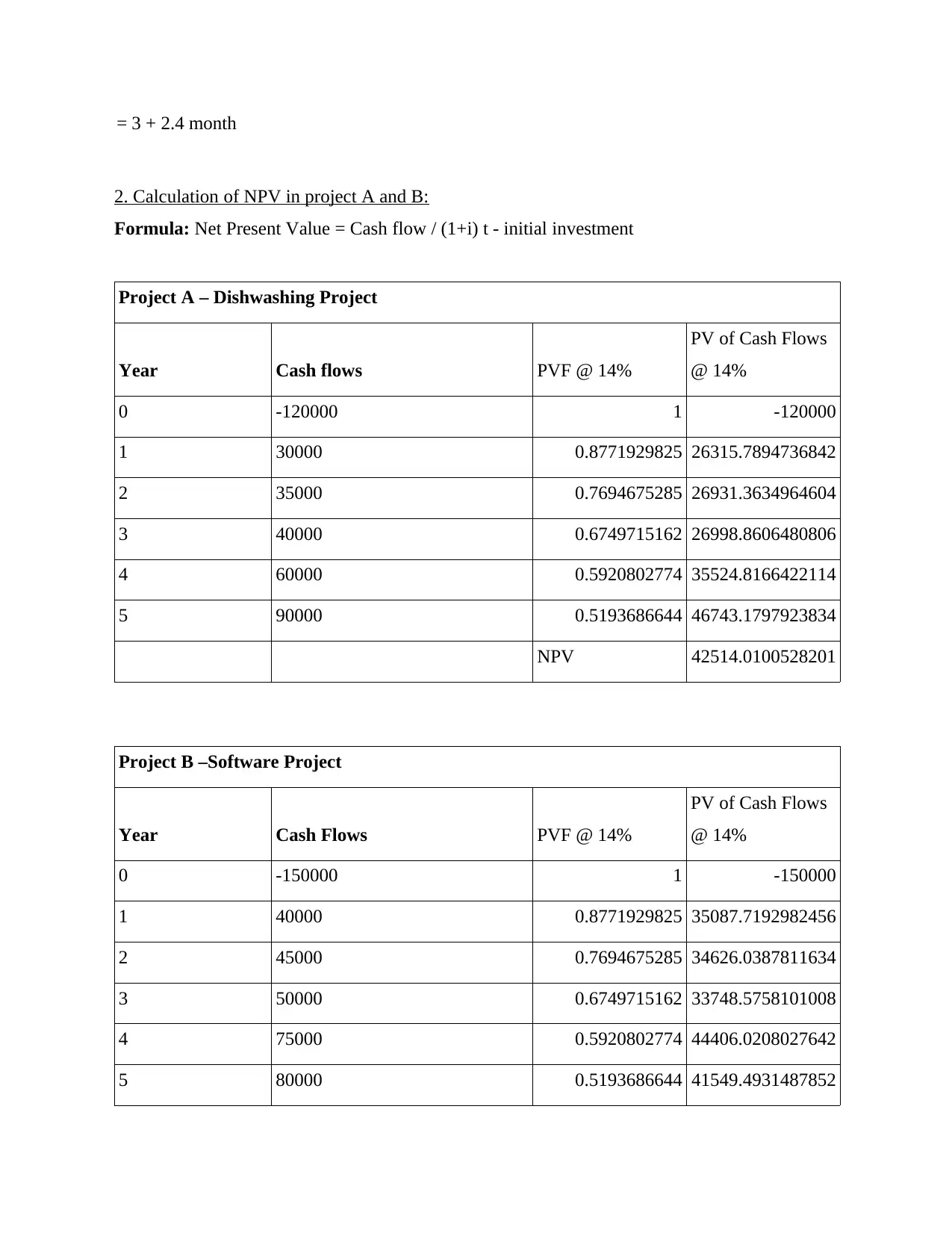
= 3 + 2.4 month
2. Calculation of NPV in project A and B:
Formula: Net Present Value = Cash flow / (1+i) t - initial investment
Project A – Dishwashing Project
Year Cash flows PVF @ 14%
PV of Cash Flows
@ 14%
0 -120000 1 -120000
1 30000 0.8771929825 26315.7894736842
2 35000 0.7694675285 26931.3634964604
3 40000 0.6749715162 26998.8606480806
4 60000 0.5920802774 35524.8166422114
5 90000 0.5193686644 46743.1797923834
NPV 42514.0100528201
Project B –Software Project
Year Cash Flows PVF @ 14%
PV of Cash Flows
@ 14%
0 -150000 1 -150000
1 40000 0.8771929825 35087.7192982456
2 45000 0.7694675285 34626.0387811634
3 50000 0.6749715162 33748.5758101008
4 75000 0.5920802774 44406.0208027642
5 80000 0.5193686644 41549.4931487852
2. Calculation of NPV in project A and B:
Formula: Net Present Value = Cash flow / (1+i) t - initial investment
Project A – Dishwashing Project
Year Cash flows PVF @ 14%
PV of Cash Flows
@ 14%
0 -120000 1 -120000
1 30000 0.8771929825 26315.7894736842
2 35000 0.7694675285 26931.3634964604
3 40000 0.6749715162 26998.8606480806
4 60000 0.5920802774 35524.8166422114
5 90000 0.5193686644 46743.1797923834
NPV 42514.0100528201
Project B –Software Project
Year Cash Flows PVF @ 14%
PV of Cash Flows
@ 14%
0 -150000 1 -150000
1 40000 0.8771929825 35087.7192982456
2 45000 0.7694675285 34626.0387811634
3 50000 0.6749715162 33748.5758101008
4 75000 0.5920802774 44406.0208027642
5 80000 0.5193686644 41549.4931487852
Paraphrase This Document
Need a fresh take? Get an instant paraphrase of this document with our AI Paraphraser
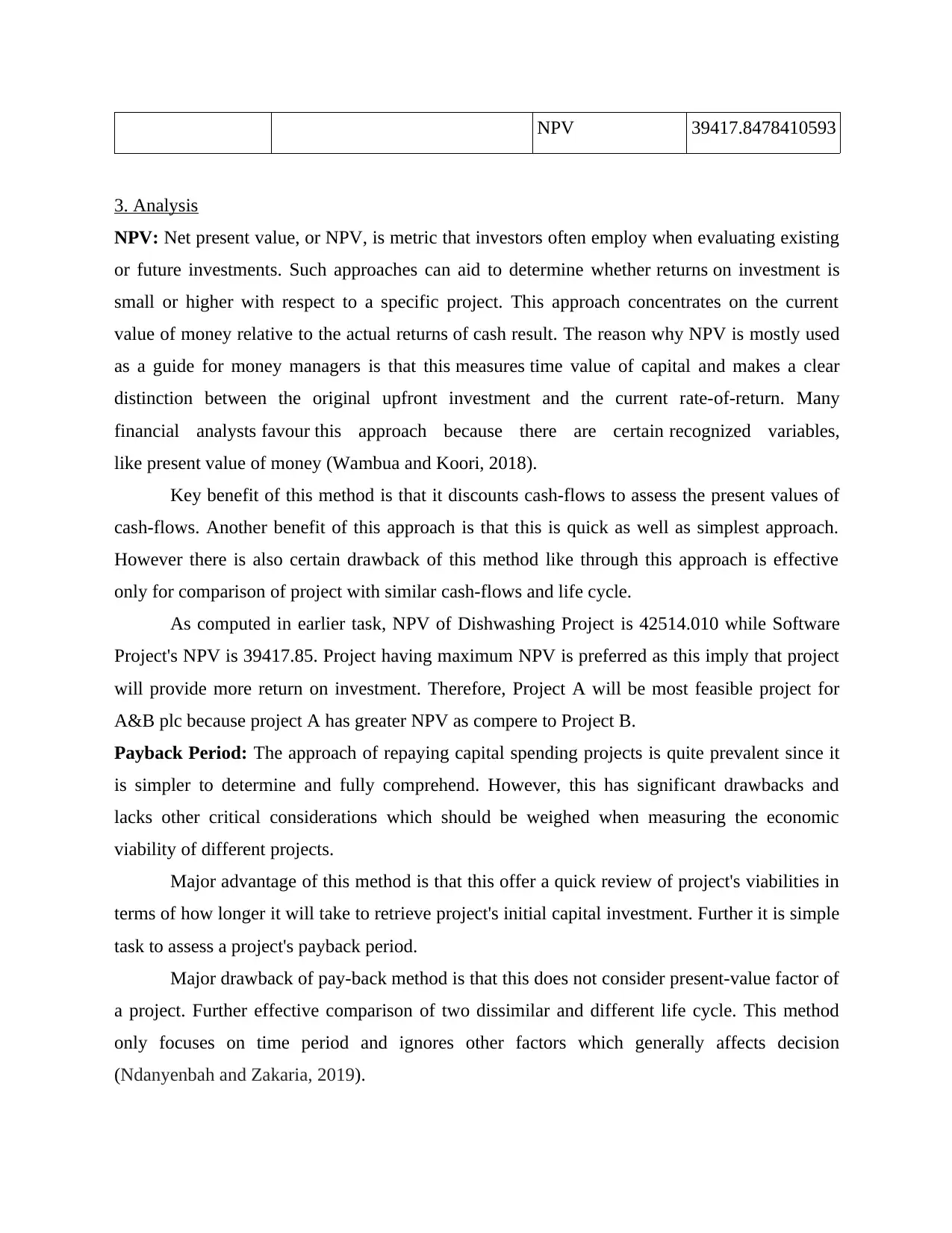
NPV 39417.8478410593
3. Analysis
NPV: Net present value, or NPV, is metric that investors often employ when evaluating existing
or future investments. Such approaches can aid to determine whether returns on investment is
small or higher with respect to a specific project. This approach concentrates on the current
value of money relative to the actual returns of cash result. The reason why NPV is mostly used
as a guide for money managers is that this measures time value of capital and makes a clear
distinction between the original upfront investment and the current rate-of-return. Many
financial analysts favour this approach because there are certain recognized variables,
like present value of money (Wambua and Koori, 2018).
Key benefit of this method is that it discounts cash-flows to assess the present values of
cash-flows. Another benefit of this approach is that this is quick as well as simplest approach.
However there is also certain drawback of this method like through this approach is effective
only for comparison of project with similar cash-flows and life cycle.
As computed in earlier task, NPV of Dishwashing Project is 42514.010 while Software
Project's NPV is 39417.85. Project having maximum NPV is preferred as this imply that project
will provide more return on investment. Therefore, Project A will be most feasible project for
A&B plc because project A has greater NPV as compere to Project B.
Payback Period: The approach of repaying capital spending projects is quite prevalent since it
is simpler to determine and fully comprehend. However, this has significant drawbacks and
lacks other critical considerations which should be weighed when measuring the economic
viability of different projects.
Major advantage of this method is that this offer a quick review of project's viabilities in
terms of how longer it will take to retrieve project's initial capital investment. Further it is simple
task to assess a project's payback period.
Major drawback of pay-back method is that this does not consider present-value factor of
a project. Further effective comparison of two dissimilar and different life cycle. This method
only focuses on time period and ignores other factors which generally affects decision
(Ndanyenbah and Zakaria, 2019).
3. Analysis
NPV: Net present value, or NPV, is metric that investors often employ when evaluating existing
or future investments. Such approaches can aid to determine whether returns on investment is
small or higher with respect to a specific project. This approach concentrates on the current
value of money relative to the actual returns of cash result. The reason why NPV is mostly used
as a guide for money managers is that this measures time value of capital and makes a clear
distinction between the original upfront investment and the current rate-of-return. Many
financial analysts favour this approach because there are certain recognized variables,
like present value of money (Wambua and Koori, 2018).
Key benefit of this method is that it discounts cash-flows to assess the present values of
cash-flows. Another benefit of this approach is that this is quick as well as simplest approach.
However there is also certain drawback of this method like through this approach is effective
only for comparison of project with similar cash-flows and life cycle.
As computed in earlier task, NPV of Dishwashing Project is 42514.010 while Software
Project's NPV is 39417.85. Project having maximum NPV is preferred as this imply that project
will provide more return on investment. Therefore, Project A will be most feasible project for
A&B plc because project A has greater NPV as compere to Project B.
Payback Period: The approach of repaying capital spending projects is quite prevalent since it
is simpler to determine and fully comprehend. However, this has significant drawbacks and
lacks other critical considerations which should be weighed when measuring the economic
viability of different projects.
Major advantage of this method is that this offer a quick review of project's viabilities in
terms of how longer it will take to retrieve project's initial capital investment. Further it is simple
task to assess a project's payback period.
Major drawback of pay-back method is that this does not consider present-value factor of
a project. Further effective comparison of two dissimilar and different life cycle. This method
only focuses on time period and ignores other factors which generally affects decision
(Ndanyenbah and Zakaria, 2019).
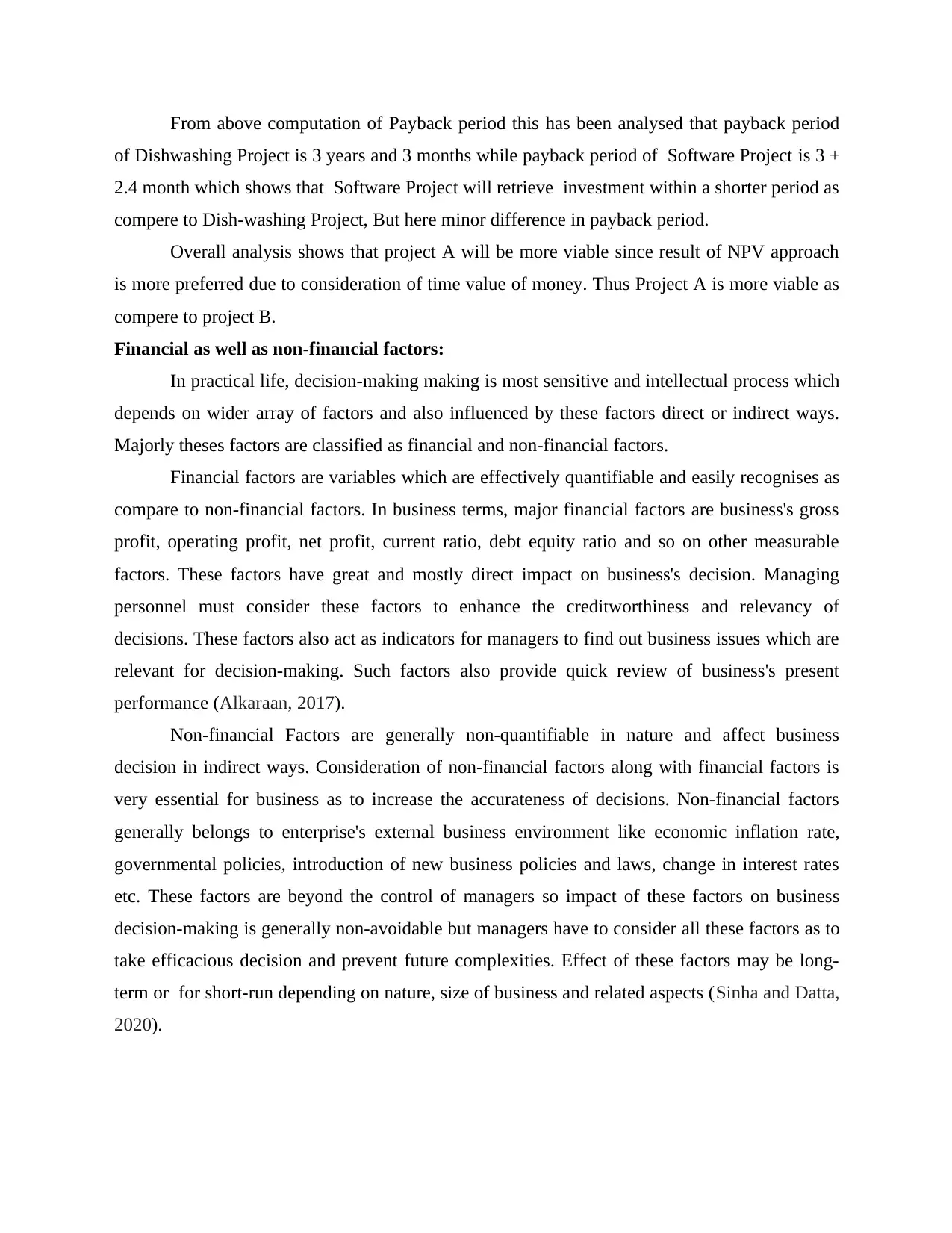
From above computation of Payback period this has been analysed that payback period
of Dishwashing Project is 3 years and 3 months while payback period of Software Project is 3 +
2.4 month which shows that Software Project will retrieve investment within a shorter period as
compere to Dish-washing Project, But here minor difference in payback period.
Overall analysis shows that project A will be more viable since result of NPV approach
is more preferred due to consideration of time value of money. Thus Project A is more viable as
compere to project B.
Financial as well as non-financial factors:
In practical life, decision-making making is most sensitive and intellectual process which
depends on wider array of factors and also influenced by these factors direct or indirect ways.
Majorly theses factors are classified as financial and non-financial factors.
Financial factors are variables which are effectively quantifiable and easily recognises as
compare to non-financial factors. In business terms, major financial factors are business's gross
profit, operating profit, net profit, current ratio, debt equity ratio and so on other measurable
factors. These factors have great and mostly direct impact on business's decision. Managing
personnel must consider these factors to enhance the creditworthiness and relevancy of
decisions. These factors also act as indicators for managers to find out business issues which are
relevant for decision-making. Such factors also provide quick review of business's present
performance (Alkaraan, 2017).
Non-financial Factors are generally non-quantifiable in nature and affect business
decision in indirect ways. Consideration of non-financial factors along with financial factors is
very essential for business as to increase the accurateness of decisions. Non-financial factors
generally belongs to enterprise's external business environment like economic inflation rate,
governmental policies, introduction of new business policies and laws, change in interest rates
etc. These factors are beyond the control of managers so impact of these factors on business
decision-making is generally non-avoidable but managers have to consider all these factors as to
take efficacious decision and prevent future complexities. Effect of these factors may be long-
term or for short-run depending on nature, size of business and related aspects (Sinha and Datta,
2020).
of Dishwashing Project is 3 years and 3 months while payback period of Software Project is 3 +
2.4 month which shows that Software Project will retrieve investment within a shorter period as
compere to Dish-washing Project, But here minor difference in payback period.
Overall analysis shows that project A will be more viable since result of NPV approach
is more preferred due to consideration of time value of money. Thus Project A is more viable as
compere to project B.
Financial as well as non-financial factors:
In practical life, decision-making making is most sensitive and intellectual process which
depends on wider array of factors and also influenced by these factors direct or indirect ways.
Majorly theses factors are classified as financial and non-financial factors.
Financial factors are variables which are effectively quantifiable and easily recognises as
compare to non-financial factors. In business terms, major financial factors are business's gross
profit, operating profit, net profit, current ratio, debt equity ratio and so on other measurable
factors. These factors have great and mostly direct impact on business's decision. Managing
personnel must consider these factors to enhance the creditworthiness and relevancy of
decisions. These factors also act as indicators for managers to find out business issues which are
relevant for decision-making. Such factors also provide quick review of business's present
performance (Alkaraan, 2017).
Non-financial Factors are generally non-quantifiable in nature and affect business
decision in indirect ways. Consideration of non-financial factors along with financial factors is
very essential for business as to increase the accurateness of decisions. Non-financial factors
generally belongs to enterprise's external business environment like economic inflation rate,
governmental policies, introduction of new business policies and laws, change in interest rates
etc. These factors are beyond the control of managers so impact of these factors on business
decision-making is generally non-avoidable but managers have to consider all these factors as to
take efficacious decision and prevent future complexities. Effect of these factors may be long-
term or for short-run depending on nature, size of business and related aspects (Sinha and Datta,
2020).
⊘ This is a preview!⊘
Do you want full access?
Subscribe today to unlock all pages.

Trusted by 1+ million students worldwide

CONCLUSION
From above study-assessment this has been analysed that decision-making within
business entity essential and valuable process which help management to ensure
accomplishment of business goals. Under this process managers evaluates each steps to make
final decision. There are wide range of techniques which supports managers' decision and also
act as guidance for them.
From above study-assessment this has been analysed that decision-making within
business entity essential and valuable process which help management to ensure
accomplishment of business goals. Under this process managers evaluates each steps to make
final decision. There are wide range of techniques which supports managers' decision and also
act as guidance for them.
Paraphrase This Document
Need a fresh take? Get an instant paraphrase of this document with our AI Paraphraser
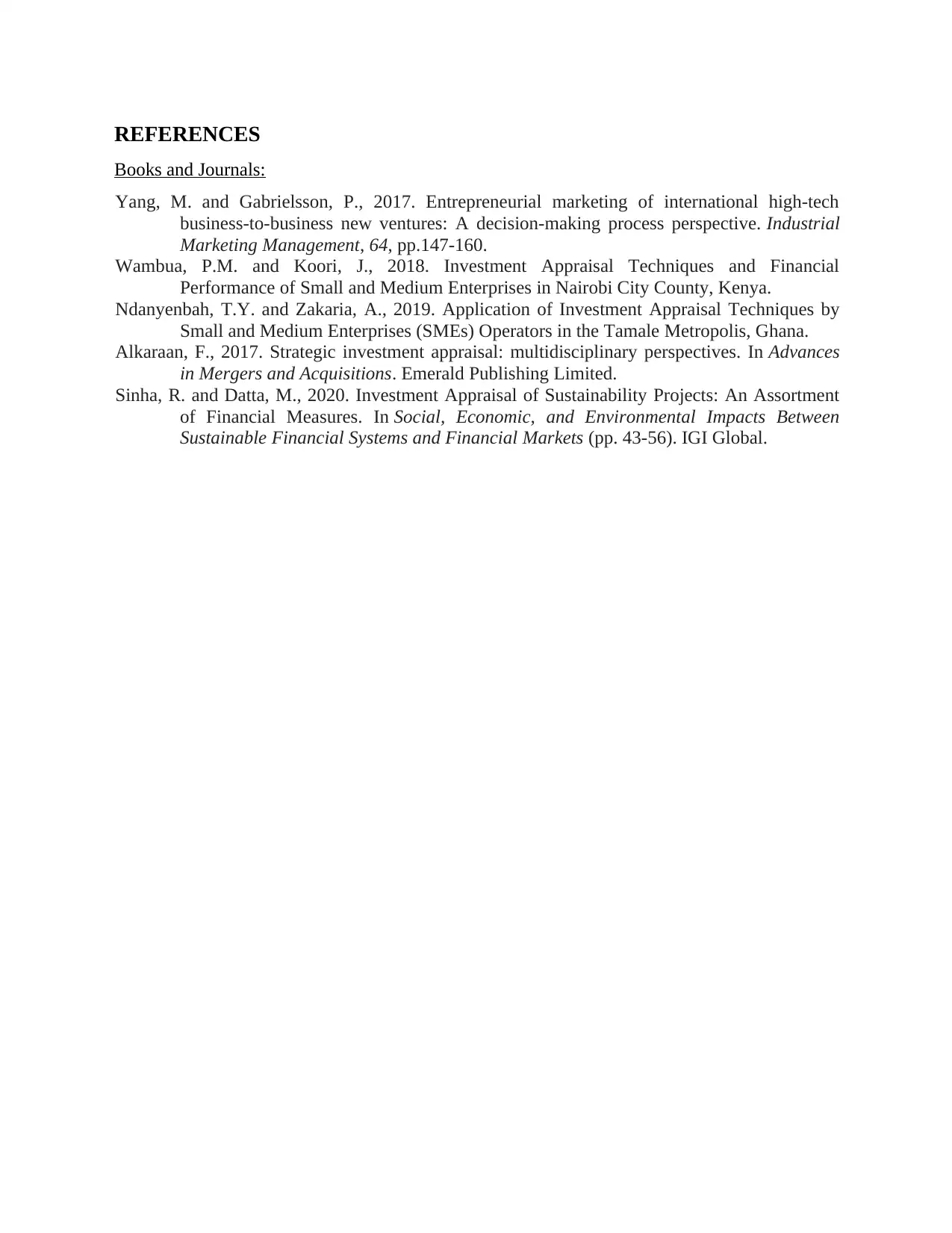
REFERENCES
Books and Journals:
Yang, M. and Gabrielsson, P., 2017. Entrepreneurial marketing of international high-tech
business-to-business new ventures: A decision-making process perspective. Industrial
Marketing Management, 64, pp.147-160.
Wambua, P.M. and Koori, J., 2018. Investment Appraisal Techniques and Financial
Performance of Small and Medium Enterprises in Nairobi City County, Kenya.
Ndanyenbah, T.Y. and Zakaria, A., 2019. Application of Investment Appraisal Techniques by
Small and Medium Enterprises (SMEs) Operators in the Tamale Metropolis, Ghana.
Alkaraan, F., 2017. Strategic investment appraisal: multidisciplinary perspectives. In Advances
in Mergers and Acquisitions. Emerald Publishing Limited.
Sinha, R. and Datta, M., 2020. Investment Appraisal of Sustainability Projects: An Assortment
of Financial Measures. In Social, Economic, and Environmental Impacts Between
Sustainable Financial Systems and Financial Markets (pp. 43-56). IGI Global.
Books and Journals:
Yang, M. and Gabrielsson, P., 2017. Entrepreneurial marketing of international high-tech
business-to-business new ventures: A decision-making process perspective. Industrial
Marketing Management, 64, pp.147-160.
Wambua, P.M. and Koori, J., 2018. Investment Appraisal Techniques and Financial
Performance of Small and Medium Enterprises in Nairobi City County, Kenya.
Ndanyenbah, T.Y. and Zakaria, A., 2019. Application of Investment Appraisal Techniques by
Small and Medium Enterprises (SMEs) Operators in the Tamale Metropolis, Ghana.
Alkaraan, F., 2017. Strategic investment appraisal: multidisciplinary perspectives. In Advances
in Mergers and Acquisitions. Emerald Publishing Limited.
Sinha, R. and Datta, M., 2020. Investment Appraisal of Sustainability Projects: An Assortment
of Financial Measures. In Social, Economic, and Environmental Impacts Between
Sustainable Financial Systems and Financial Markets (pp. 43-56). IGI Global.
1 out of 8
Related Documents
Your All-in-One AI-Powered Toolkit for Academic Success.
+13062052269
info@desklib.com
Available 24*7 on WhatsApp / Email
![[object Object]](/_next/static/media/star-bottom.7253800d.svg)
Unlock your academic potential
Copyright © 2020–2025 A2Z Services. All Rights Reserved. Developed and managed by ZUCOL.





